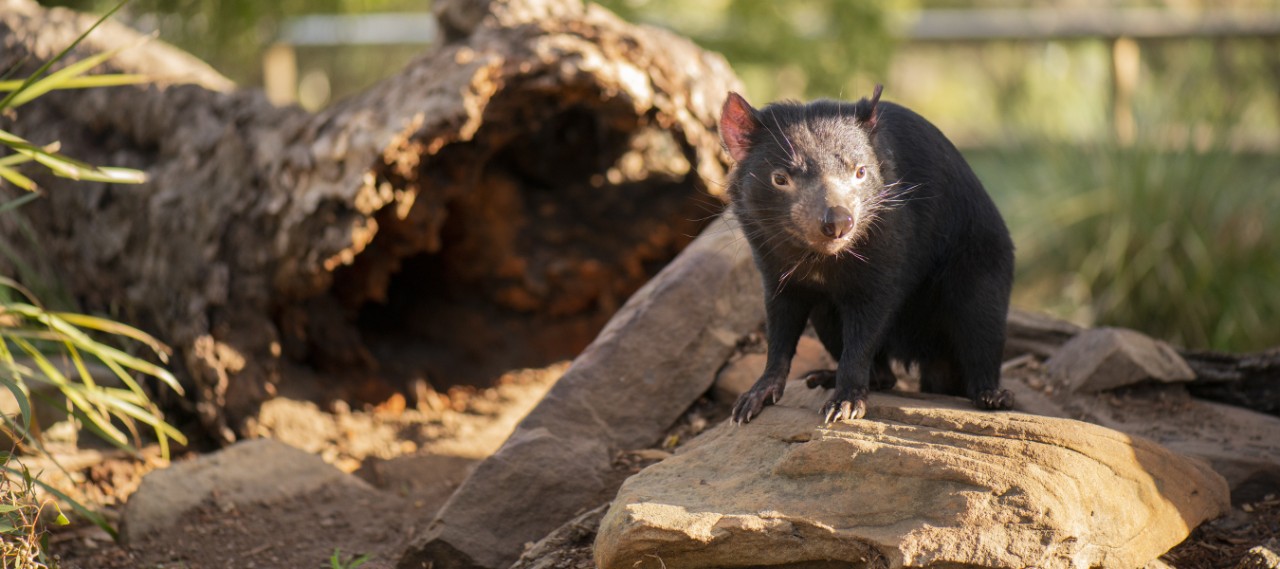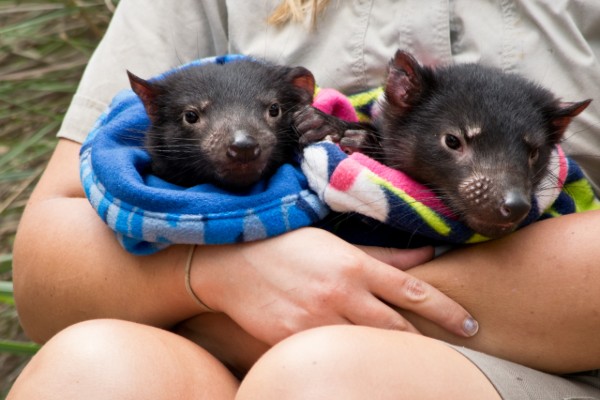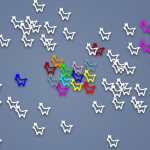
What can we learn from the devil?
The Tasmanian devil, of course.
There’s a lot of talk about preservation of species and breeds these days, which is great for purebred dog breeders. Breed preservation is really our most important larger mission – we are all guardians of an historic breed that will live beyond us. We want them to be healthy and happy and available to our grandchildren and beyond.
In today’s world, where we’ve had regular reports from the UN on the decline in genetic diversity in wild and domestic species, there are, of course, thousands of scientists all over the world trying to conserve whole species of endangered animals. We can learn a great deal from their efforts, and in fact everything we do at BetterBred is based on the peer reviewed principles of leading conservationists and population geneticists – customized to meet the needs of the modern, conscientious dog breeder.
One such endangered species is the Tasmanian Devil, a rare marsupial which is threatened due to a contagious cancer called Devil Facial Tumor Disease. Researchers believe that the widespread biological inability of this species to mount an immune response that will reject these tumors may be caused by a lack of genetic diversity in their declining population. Apparently there was a genetic bottleneck about 100 years ago that severely limited diversity in the species, and now they are susceptible to this deadly cancer their immune systems cannot fight.

Interestingly, the conservationists in charge of preserving the Tasmanian devil have similar, if more severe, challenges maintaining the health and viability of that species as those dog breeders have for our purebred dogs. While physiology, appearance, diet, habitats, and mating systems are unique to each complex species, many population genetics concepts are generally applicable across the board, and so we breeders can look at efforts to preserve this rare animal and others to help us learn how best to preserve our breeds.
Ultimately small populations without ample existing diversity – like the devil, as well as some dog breeds – can suffer from dysfunctional immune systems, lowered reproduction rates, and an inability as a population to adapt to new environments or disease. Conservationists therefore have long been keen to track the amounts and potential loss of diversity in their breeding programs. There are, therefore, many programs around the world breeding captive and endangered animals and using what they know to maintain diversity.
Originally tracking diversity was done via pedigrees whenever possible, though parentage in wild animals is not always easy to establish. Monitoring the genetic diversity of species with DNA testing, most often with microsatellites like the VGL canine diversity test uses, therefore, has been standard procedure for as long as 20 years. While pedigrees can be effective to a point in carefully observed populations, many studies in recent years have shown that pedigrees alone cannot account for the variance of diversity among closely related animals. Moreover, pedigrees are easily skewed by inaccuracy, incompleteness, lack of depth, and unknown levels of relatedness in the earliest recorded ancestors. Therefore DNA testing is now the norm, and with constant innovation in DNA testing methods and lowered cost, more and more methods of assessing genetic diversity have become available.
In one study, SNP data contradicted years of microsatellite data that showed that three species of Galapagos giant tortoises were separate species. The researchers thought that due simply to the larger number of markers in SNPs, their information was superior. It took a follow up study of better selected SNPs to confirm what decades of genetic data had already said – the three tortoises were in fact separate species.
Nevertheless, there is no uniformity to approaches yet. Different datasets produce different results and different methods of analysis produce different results. Results depend on various biological elements unique to each species or population, such as more or fewer chromosomes with a range of mutation rates, varying mating habits, and a vast spectrum of existing diversity. Some species have lots – some little – and this can influence results. Some species have much research interest and have reliable maps of their genomes, some still don’t. All of these can influence how conservationists track species and devise their breeding programs.
Breeders tend to think of scientists as being able to provide very definitive answers to many of our questions about the best way forward – but researchers vary in their techniques, interests and opinions in this as much as in any field. Livestock breeders use genomic testing to produce animals with high production value (more milk, more meat etc.) whereas conservation program managers are more concerned with retention of diversity and survival of animals bred in captivity and released into the wild.
With new methods that have little track record, researchers can easily leap to erroneous conclusions. In one study, SNP data contradicted years of microsatellite data that showed that three species of Galapagos giant tortoises were separate species. The researchers thought that due simply to the larger number of markers in SNPs, their information was superior. It took a follow up study of better selected SNPs to confirm what decades of genetic data had already said – the three tortoises were in fact separate species. This illustrates how careful we breeders must be when adopting new methods – and why we trust the world renowned, well published, experienced veterinarians and conservation geneticists at UC Davis’ Veterinary Genetics Laboratory.
There is also ample published independent research that we dog breeders can look at to illuminate our own path forward. Long term studies are helpful – not just for assessing existing diversity – there are lots of studies on that – but also for looking at successful species management programs. Not unlike modern research for purebred dogs, there are two necessary areas of study in Tasmanian devils. One is research on their terrifying contagious cancer, its genetic causes and pathology, and the other is the very separate effort to preserve the species. As for many threatened species, conservationists are tasked with managing a breeding program for devils that has as its primary goal to retain as much of the genetic variation in the original population as possible, in order to keep the species healthy and avoid too much inbreeding for generations to come.
Both research on disease causation and research for breeding programs require DNA testing, but these two areas of inquiry are looking at completely different necessary aspects of preservation.
In the case of the devil, like in dogs, both are of crucial importance. Studying the disease offers insight into this very specific and alarming contagious cancer – while studying the overall genetic diversity of each animal, its family and the whole species allows conservationists to help preserve the existing diversity in the breed. It’s important to preserve unaffected devils because once a single animal in a colony is infected, the disease can decimate a whole colony in 12-18 months.
Conservationists have therefore developed different strategies to combat the disease and preserve the species – including trapping affected animals and removing them, and also using unaffected animals to create two healthy “insurance populations,” one in captivity and one on an island. These researchers have carefully studied and adapted their breeding strategies over the last decade using most of the same peer reviewed methods we use at BetterBred. They have to decide which animals should go to which breeding population in order to preserve diversity, and in doing so they’ve learned a few things. One thing they discovered is that just adding the most heterozygous or least inbred devils alone is not enough to keep population wide heterozygosity low. Another is that reproductive success in Tasmanian devils is associated with heterozygosity in the Class I MHC region – like the Class I DLA in dogs that is available only from the VGL canine diversity test. One more is that various DNA methods measure different things – so the same inbreeding calculation using one set of data may have very different results from another set of data – for the same animals. It’s therefore clearly very important to know which markers measure which aspects of diversity and how best to use them in any breeding program.
Not only are there various available DNA testing molecular data types (neutral microsatellites, MHC microsatellites, traditional single nucleotide polymorphism sequencing, reduced representation sequencing and more) but also each genome can be sampled at different locations with potentially different meanings, they can be sampled with lots of markers or fewer, and the data can be analyzed by dozens of different available software packages and methods.
One thing they discovered is that just adding the most heterozygous or least inbred devils alone is not enough to keep population wide heterozygosity low. Another is that reproductive success in Tasmanian devils is associated with heterozygosity in the Class I MHC region – like the Class I DLA in dogs that is available only from the VGL canine diversity test.
While DNA test methods are often chosen based on practical considerations like cost, turn around time for results, typical quality of samples, acceptable error rates, and whether a good map of the genome exists already for a species, methods of analysis are largely subject to preference and application to areas of research. Selecting the right conservation genetics algorithms to analyze each individual dataset is also important, and there are hundreds of combinations of datasets and algorithms available.
To determine genetic relatedness for instance, consensus among researchers is that it is best to try available algorithms, compare them to known relationships and use the formulas that are most accurate in predicting those known relationships. By assessing relatedness and not merely inbreeding, researchers have been able to address the issue of better founder representation. In one important paper they see what we do at BetterBred in dogs – that pedigree-based software can do a disservice to conservation breeding programs because they do not usually accurately account for relatedness between founders. This is why, during the research phase of sampling any new breed, we urge contributing breeders to find the broadest range of families within a breed to sample.
Using DNA based breeding management methods is how conservationists are saving the endangered Tasmanian devil – and in doing so they help confirm for us that we established BetterBred breeding tools on sound, peer reviewed principles developed using long term studies. Tasmanian devils are only one such study of course – wolves, fish, birds of many kinds, many sea mammals are all tracked with similar methods and conservation breeding programs the world over are working to keep the species in their care safe and viable. So, too, is the goal of the conscientious dog breeders who use BetterBred to enhance the power of their preservation breeding programs.
 Previous Post
Previous Post Next Post
Next Post


